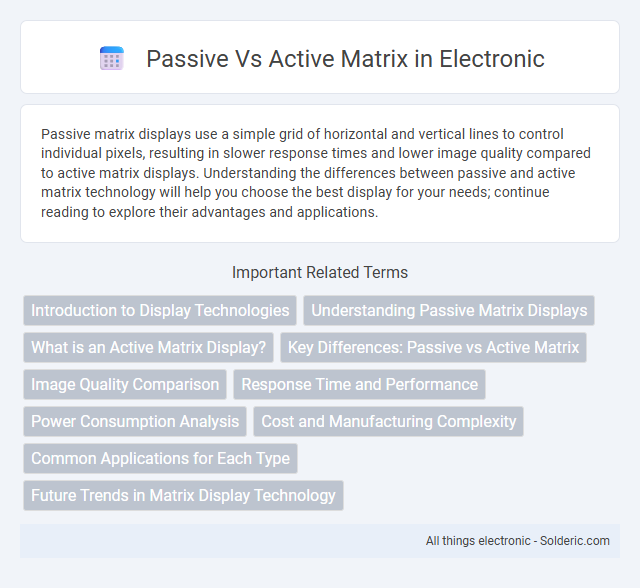Passive matrix displays use a simple grid of horizontal and vertical lines to control individual pixels, resulting in slower response times and lower image quality compared to active matrix displays. Understanding the differences between passive and active matrix technology will help you choose the best display for your needs; continue reading to explore their advantages and applications.
Comparison Table
| Feature | Passive Matrix | Active Matrix |
|---|---|---|
| Technology | Simple grid of conductive lines; pixels controlled at intersections | Thin-Film Transistor (TFT) at each pixel for precise control |
| Image Quality | Lower resolution, limited color accuracy, and slower response time | Higher resolution, improved color accuracy, and faster response time |
| Refresh Rate | Slower refresh rates causing ghosting and blurring | Faster refresh rates for smoother motion display |
| Power Consumption | Generally lower power consumption | Higher power consumption due to active circuitry |
| Cost | Lower manufacturing cost | Higher manufacturing cost due to complexity |
| Common Uses | Older LCDs, basic displays, calculators | Modern smartphones, tablets, laptops, HDTVs |
Introduction to Display Technologies
Passive matrix displays use a simple grid of conductive lines to control pixels, resulting in slower response times and lower image quality compared to active matrix technology. Active matrix displays incorporate thin-film transistors (TFTs) to actively control each pixel, enabling faster refresh rates and sharper images. Your choice between these technologies impacts display performance, with active matrix being preferred for higher-resolution screens like modern LCDs and OLEDs.
Understanding Passive Matrix Displays
Passive matrix displays control pixels using a simple grid of conductive lines, resulting in slower response times and lower contrast compared to active matrix screens. These displays consume less power, making them suitable for basic devices like calculators and digital watches. Understanding passive matrix technology helps you choose the right display type for applications where cost and battery life are priorities over high-resolution graphics.
What is an Active Matrix Display?
An Active Matrix Display uses thin-film transistors (TFTs) to control each individual pixel, providing faster response times and higher resolution compared to passive matrix displays. This technology enhances image quality and reduces motion blur, making it ideal for smartphones, tablets, and high-definition televisions. Your viewing experience improves significantly with an active matrix due to more precise control of pixels and better overall display performance.
Key Differences: Passive vs Active Matrix
Passive matrix displays control pixels using a simple grid of conductive lines, resulting in slower response times and lower resolution suitable for basic screens like calculators. Active matrix technology uses thin-film transistors (TFT) to control each pixel individually, allowing for faster refresh rates, higher resolution, and better image quality ideal for smartphones and modern monitors. Your choice between passive and active matrix impacts display clarity, power consumption, and overall performance depending on the device requirements.
Image Quality Comparison
Active matrix displays offer superior image quality through faster response times and higher refresh rates, resulting in clearer motion rendering and reduced blur compared to passive matrix displays. The finer control of individual pixels in active matrix technology enables better color accuracy, contrast, and brightness levels. Passive matrix screens often exhibit ghosting and lower resolution, leading to diminished sharpness and less vibrant images.
Response Time and Performance
Active matrix displays offer significantly faster response times due to individually controlled thin-film transistors (TFTs) that manage each pixel, resulting in smoother motion and reduced blur in high-performance applications. Passive matrix screens rely on grid-driven pixels, which cause slower response times and increased ghosting, making them less suitable for fast-moving visuals. Consequently, active matrix technology is preferred in devices requiring high refresh rates and superior image clarity, such as modern smartphones and gaming monitors.
Power Consumption Analysis
Active matrix displays consume more power due to constant refreshing of individual pixels driven by thin-film transistors (TFTs), providing higher image quality and faster response times. Passive matrix displays use less power by addressing pixels in a row-column scanning method but suffer from lower resolution and slower refresh rates. Your device's power efficiency critically depends on choosing between active matrix for performance or passive matrix for battery saving.
Cost and Manufacturing Complexity
Passive matrix displays are typically more cost-effective due to their simpler construction and fewer components, making them easier to manufacture on a large scale. Active matrix displays involve a more complex manufacturing process with thin-film transistor (TFT) arrays that increase production costs and require advanced fabrication technology. This complexity results in higher performance but also contributes to a significant price difference compared to passive matrix alternatives.
Common Applications for Each Type
Passive matrix displays are commonly used in simple devices such as digital watches, calculators, and basic mobile phones due to their lower cost and simpler design. Active matrix displays dominate in smartphones, tablets, laptops, and high-definition televisions, offering superior image quality, faster response times, and better color reproduction. The popularity of active matrix technology in devices like OLED and LCD screens highlights its importance for applications requiring high resolution and dynamic visuals.
Future Trends in Matrix Display Technology
Future trends in matrix display technology emphasize advancements in both passive and active matrix designs, with active matrix OLED (AMOLED) displays leading innovation due to superior resolution, faster response times, and enhanced energy efficiency. Flexible and transparent display technologies are increasingly integrated into active matrix systems, enabling new applications in wearable devices and foldable screens. Your experience in digital displays will benefit from emerging materials like quantum dots and microLEDs, which promise brighter visuals and longer lifespans, pushing the boundaries of matrix display capabilities.
Passive vs Active matrix Infographic

 solderic.com
solderic.com